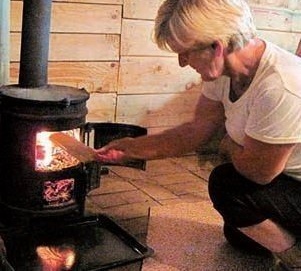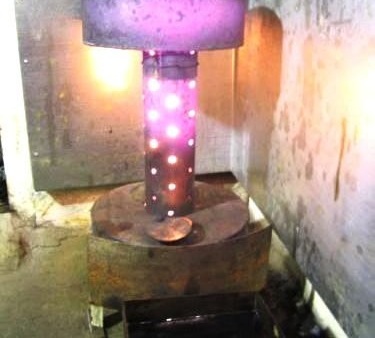Homemade stove on diesel fuel for heating the garage: analysis of 3 designs
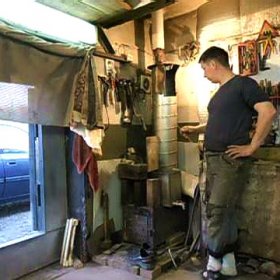
Warm days end, but while summer is still in the yard, it's time to think about a winter cold and a warm room for a car. After all, as you know, the battery does not like colds. Even if it contains gel electrolyte, the capacity will fall, the oil will thicken in the cold, each time you have to start the car with adventures. And the engine, while warming up, will eat a lot of fuel. If you have to do something in the garage, then it’s unlikely that you will get much to work with your fingers that are not bent by frost. Garage stoves are available for sale, but how effective they are is a big question. They say that a home-made miracle in a diesel fuel furnace for heating a garage is the best option. Let's figure out how to make it.
Content
Safety Rules Above All
The do-it-yourself stove in a diesel fuel that we are going to do is perfect not only for the garage, but also for basements, for various buildings in the summer cottage, and especially for greenhouses.
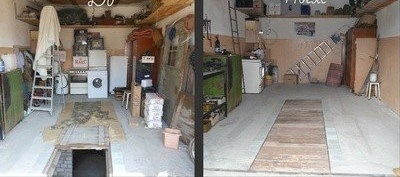
It seems that the order in the garage is a private matter for everyone. But, having realized the danger of fire, from which not only your property, but also neighboring garages can suffer, you come to the conclusion - it is better to protect yourself
The garage is a special place. Firstly, it stores valuable property - a car and many other things, the true importance of which can only be understood by mechanics - enthusiasts. Secondly, flammable substances can always be present here. Therefore, before starting work, it is necessary to know the fire safety rules. Still, we are going to do the source of increased danger.
- The unit should not be installed in areas of likely drafts.
- The finished design can not be placed where flammable objects can get inside the stove.
- Despite the limited garage space, you need to put it this way heaterso that there is at least half a meter free space around it.
- Exclude the presence of combustible substances and rags soaked in mining nearby.
In our next article you will find a detailed guide for the manufacture of stove stoves:https://aquatech.tomathouse.com/en/otoplenie/bani-i-garazh/pechka-burzhujka-svoimi-rukami.html.
A carbon dioxide fire extinguisher will also help protect yourself, and it is better to take two such devices for fidelity. The fire extinguisher must be automatic and non-volatile. Estimate that the volume of gas produced by him was at least 1.5 times the cubic capacity of the garage. Focus on 5 kg.
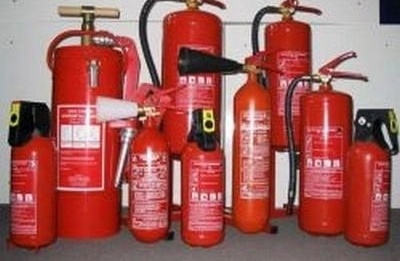
Quite a lot of fire extinguishers are produced, they are designed for a variety of purposes. For a garage, choose carbon dioxide, automatic and non-volatile, and preferably two
With a simple opening of the valve of such a fire extinguisher, nothing will happen: a special membrane will reliably protect the contents of the cylinder.If it is heated to about 70 degrees and above, the membrane will unfold and pierce with a tip, and the gas will begin to come out.
The principle of operation of the "solar" heater
To correctly make a garage ovenworking on diesel fuel, you need to have a good idea of its structure and principle of operation.
If the furnace tank is made with a volume calculated for two liters of diesel fuel, neither smoke nor soot will be emitted during operation. But what is formed at the time of ignition of the stove cannot be called useful. If the oven can be moved, then at this time it is better to remove it from the garage, so as not to breathe harmful emissions. The garage itself, where the device will work, must be well ventilated.
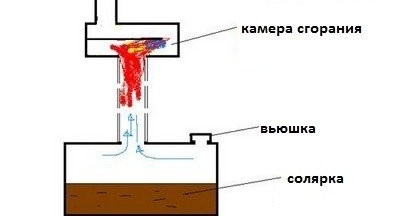
The principle of operation of the stove in diesel fuel is quite simple. An ignition procedure is required, after which the temperature of the diesel fuel will begin to rise, and its vapor will burn when it enters the combustion chamber
The diesel fuel in the wick cup from the fuel tank must come under the influence of gravity (by gravity). Using the adjustment, we will dose the amount of incoming fuel. The fuel in the wick cup is heated, acquiring a gaseous state. In the combustion chamber itself, fumes are coming in, which will burn. If all the elements in this chamber are placed compactly, the fuel will burn evenly.
The spiral, which is placed in the upper part of this chamber, is able to heat up to 800 ° C. Combustion products must be removed through a chimney. If everything is done correctly, the design will turn out not only economical, but also absolutely safe. All combustible compounds must be completely destroyed in the chamber, and side - is discharged through the chimney.
Such a furnace is really economical, since diesel fuel differs from the same kerosene in increased density. It is enough for a long time, because it is spent economically. The advantage of such a structure is its convenient design. The top module can be used, for example, for boiling water or cooking. The main disadvantage of the device can be considered high prices for petroleum products.
Homemade Design Options
The units that we are offered in stores are designed for average working conditions. A home-made device is good in that the owner of the garage, knowing his own needs, can make a furnace that perfectly meets the expected operating conditions. It will be more efficient and more economical.
Construction # 1 - gas cylinder stove
The used gas (carbon or oxygen) cylinder can serve as the main one for the manufacture of the furnace. Fuel will flow by gravity, and forced air supply with this design is not needed. The heating of the cylinder to fire hazardous temperatures must be prevented by setting the height of the circuit of the device according to the height of the combustion source inside.
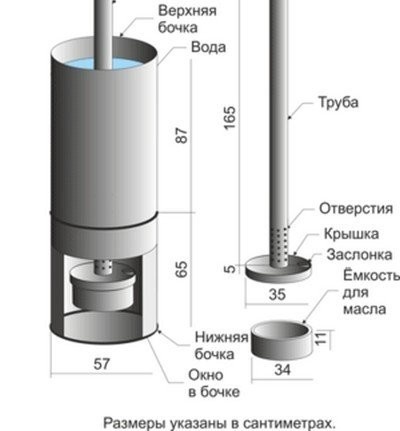
This diagram shows in sufficient detail and with dimensions in centimeters the design of the stove in diesel fuel using a second-hand gas cylinder
Since we will do the furnace in diesel fuel with our own hands, it is necessary to prepare all the material in advance. We will need:
- 50-liter seamless cylinder with walls up to 1.5 cm;
- pipes for the manufacture of a chimney (length - from 4 m, wall thickness up to 2 mm, inner diameter from 10 cm);
- 8-15 liter fuel tank;
- copper burner pipes;
- steel corners 20cm;
- grinder and file;
- electrodes and welding machine;
- level and tape measure;
- drill and drill.
Pay attention to the wall thickness of the cylinder. We need combustible fuel vapors to form. If the walls are thicker, the temperature necessary for boiling does not reach.
On the street, condensate should be drained from the tank, rinse the container a couple of times with water so that no odorant remains in it. Then it is filled with water to the top and buried in the ground for stability. Grinder cut off the upper part of the cylinder with a valve.
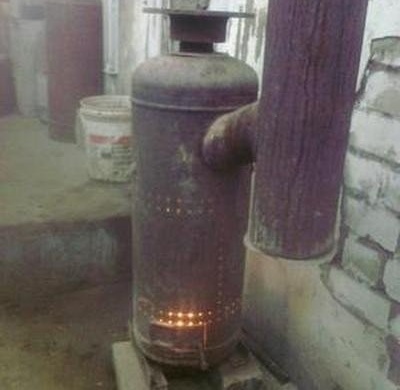
This is what the finished design from the old cylinder looks like.I must say that a stove of this volume can quickly heat a rather large room
The first cut will cause water to flow. Wait for it to drain and continue to separate the top from the bottom. The lower part will become a camera, and the upper - a lid. Using welding, we weld legs from steel corners to the bottom of the tank. We put the balloon on its legs. Now you can assemble the structure in accordance with the above figure, where all the necessary dimensions are indicated in centimeters.
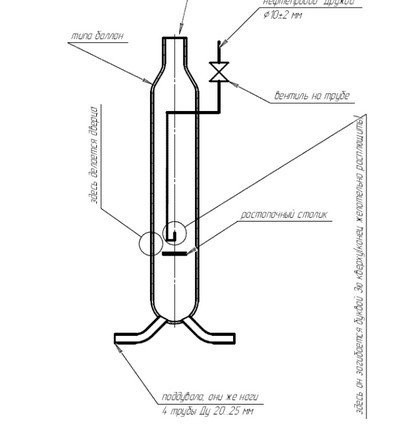
This cylinder was placed horizontally, using a rather witty solution, in which the legs of the device, for example, simultaneously act as air ducts, and the fuel supply is regulated by a valve
You should pay attention to the fact that the chimney should be vertical without corners and inclinations. The length of the chimney itself must not be less than 4 meters. In this design, you can fill in and mining, but only after preliminary cleaning. If the oil is unrefined, it may contain water or alcohol. Then, when heated, there is a danger of explosion and fire, which in a garage is especially critical!
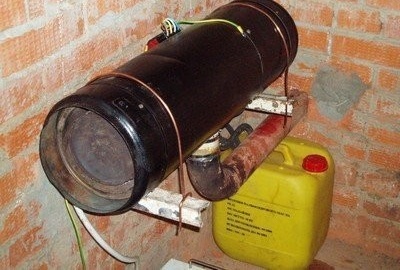
Another cylinder oven. Although petroleum products are becoming more expensive, despite the modest prices for crude oil, it is still beneficial to use diesel fuel as fuel. Its high density helps to achieve the desired effect at low cost.
Fuel is poured into 2/3 of the cylinder. A lit sheet of paper is placed on top of the diesel fuel and the stove lid is closed. Self-ignition of vapors will occur after an increase in temperature. Fuel cannot be added to a working furnace; gasoline or kerosene cannot be used in this model either.
More about this stove read here.
Construction # 2 - drip stove
If only the garage is not used as a living space in winter, then the drip design will be an excellent option for heating it. It is made quite simply and quickly.
We take an ordinary medical heating pad with a capacity of about 2 liters. To the rubber hose (about 2 meters), which is provided in the heating pad, attach a copper pipe (1-1.5 meters), bent at a right angle, that is, in the form of the letter "G". Bend the rubber hose in half. A small tin clamp equipped with a screw should be installed in place of the bend. With this simple design, we can regulate the fuel supply from the heating pad. It should drip. The heating pad should be hung on the wall. For this purpose, she has a special hole.
Now we need a rag that serves as a wick and burns. It is great if the farm has an old striped mattress. With the help of an ax, it can be cut into briquettes of 20x10x4 cm. These briquettes burn remarkably, but first they should be moistened with diesel fuel. In the absence of a mattress, you can take any rags, only you have to use the wire to turn it into all the same convenient briquettes and saturate with diesel fuel. In a large stove under a rag put a red brick, in a small one it is not needed.
As the stove itself, any metal tank will fit. For these purposes, you can use a half of a used barrel. The door should be small, if only the briquette passes. Since the artificially made door is a snap construction, the need for a special blower disappears by itself. The pipe is made of a tin, similar to a samovar, from several knees. The hole for the pipe should be away from the door.
A hole corresponding to the diameter of the copper tube is drilled in the middle of the stove. It can be done closer to the door, but further from the pipe. The entry of the pipe from the side, and not from above, made it possible to keep the planes for cooking or heating food. This stove does not need firewood, the mattress is enough for a month or two. Heat can be quickly controlled. The disadvantages include the “fragrance” of this design and its extreme fire hazard.
Read also material about what type of garage heating is the most economical:https://aquatech.tomathouse.com/en/otoplenie/bani-i-garazh/ekonomichnoe-otoplenie-dlya-garazha.html.
Construction # 3 - Steel Sheet Oven
The device made of steel sheets is very popular. It is compact (70x50x35 cm, except for the chimney) and easy enough, because weighs only 27 kg. You can cook on it, water heating is connected to it, and it is not afraid of frost.
We need:
- steel sheets 4 mm and 6 mm thick;
- chimney pipes (length from 4 m, thickness 4-5 mm and an inner diameter of 10 cm);
- 4 steel corners 20 cm for stove legs;
- copper or steel burner tubes;
- level, tape measure and hammer;
- grinder and file;
- electrodes and welding machine;
- plate bending machine.
To begin with, let's take a good look at the presented drawing and get down to work.
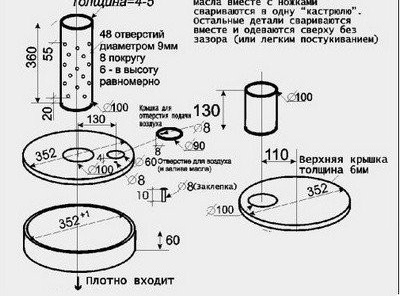
We deliberately divided this scheme into two parts, so that you can see all its details in the most detailed way. We are confident that this will help you in your work and everything will work out for you
For the reservoir, the parts are cut out with a grinder from a sheet of 4 mm, and the bottom of the firebox and the lid of the tank from a sheet of 6 mm. It is necessary to verify the quality of welding and clean the sealed seams with a file. From a sheet of 4 mm, cut a strip 115 mm wide and on a bending machine we make a ring of 34-34.5 cm in diameter from it. The strip is welded by electric welding to make a tank tube for diesel fuel. From the same sheet we cut a circle 34.5 cm in diameter - the lid of the tank for diesel fuel, which must be welded to the pipe. It remains to weld the corners and the container for diesel fuel is ready.
Now you need a sheet of 6 mm. We cut a strip of 6 cm wide from it. We turn it into a ring with a diameter of 35, 2 cm. From the same sheet we cut a circle of 35.2 cm in diameter. In the middle of this circle you need to cut a hole of 10 cm in diameter for the chimney pipe. In 4 cm to the right of this hole, we make another 5-6 cm in diameter to fill the oil. It remains to weld the ring with a circle, and we got a tank for filling oil.
The bottom of the tank is easy to make. From a sheet of 6 mm we cut a circle of 35.2 cm. A few centimeters from the edge of this circle we make a hole of 10 cm in diameter. In this case, between the centers of the circle and this hole should be about 11 cm. This was a hole for the pipe into which we will insert the chimney pipe. We make a pipe from a pipe 10 cm in diameter. To do this, cut 13 cm from it.
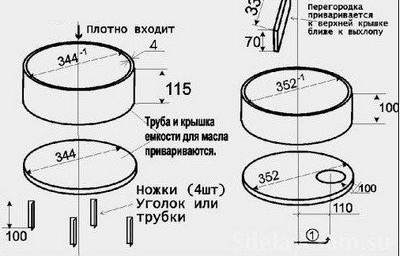
In order to make it easier for you to navigate in two parts of this diagram, we left on the left side of each part an arrow pointing down and the words “It fits tightly”: this is the same arrow
We also have to cut a 7x33 cm rectangle from a 6 mm sheet. We have a partition that needs to be welded to a circle of 35.2 cm closer to a hole of 10 cm in diameter. Insert the exhaust pipe (13cm) into the hole itself. For the burner, the pipe must be prepared: from below, at a distance of 36 cm, you need to make 48 holes of 9 mm each, that is, 6 circles of holes of 8 pcs. in each. The distance between the circles is 6 cm.
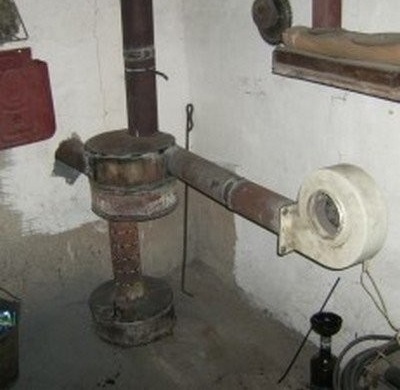
The complete oven looks modest, but it works great. You can see this if you watch the video below. It details how to ignite and so on.
The resulting pipe with holes is inserted into the lid of the tank for diesel fuel, which we made from a 4 mm sheet. You need to insert it evenly (check the level) and tightly, but do not weld. If something goes wrong, work with a file and grinder. In the hole that is in the tank for pouring, we put the exhaust pipe 16 cm long. We connect the top and bottom of the tank without welding. Did should be closely adjacent to each other. We put on top an o-ring with a diameter of 35.4 cm.
Using electric welding, we weld a tank for pouring diesel fuel into a pipe with 48 holes. On the other hand of the same pipe you need to weld the tank, which we fastened with a sealing ring. The hole for filling the diesel fuel should be equipped with a sliding plate, which will work as a shutter on the door eye.
Left mount chimney. If in the garage itself it can still be tilted, then on the street it must be placed strictly vertically so that wind does not blow. Carefully strengthen the chimney outside.
Read also the article about what a jet furnace is, what are its pros and cons, and also see the complete installation manual:https://aquatech.tomathouse.com/en/otoplenie/reaktivnaya-tyaga-na-strazhe-uyutnogo-tepla-pech-raketa-svoimi-rukami.html.
We will demonstrate the work of this design to you in the video:
